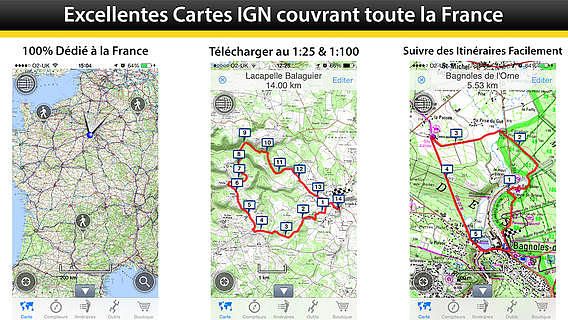

Grand Prix racers were smitten, however, with Stirling Moss once remarking: “I don't know a more wonderful track than Charade.” Constant problems with rocks falling onto the circuit – which ended up costing current Red Bull motorsport advisor Dr Helmut Marko an eye back in 1972 – and a lack of space to put in run-off areas sadly put paid to Charade’s spot on the F1 calendar.
Gps tracks france drivers#
It was so undulating, in fact, that 1967 world champion Denny Hulme reckoned that drivers continued to wear open-face helmets at Clermont-Ferrand so that they could throw up more easily!
Gps tracks france full#
The track was a full five miles long and, with its lack of straights and assortment of over 50 corners, resembled a tarmac rally stage more than a Grand Prix circuit. Formula 1 arrived at the circuit in 1965, with Jim Clark taking victory that year in his Lotus 25. Part designed by 1950 Le Mans winner Louis Rosier, racing began at the track in 1958 – although sadly Rosier died before getting to see his project reach fruition. Winding its way around a pair of extinct volcanos in central France, the Clermont-Ferrand track – or the Circuit de Charade, to give it its proper name – was another fast and undulating road course in the mould of Rouen. So ran legendary F1 journalist Denis Jenkinson’s report in Motorsport Magazine after the 1972 French Grand Prix. "Magnificent, Terrific, Superb, The Best in Europe, Marvellous, Beautiful" were all expressions heard continuously… The circuit of Charade ranks among the best and sorts out those who can drive from those who are just trying to kid us.’ ‘The words of praise that were showered on the circuit were almost embarrassing.
Gps tracks france driver#
Robert Manzon’s fourth place stands as the best finish by a French driver at Rouen. Dan Gurney won twice at Rouen, with his 1962 victory standing as the only win for Porsche as a constructor in Formula 1.

Unfortunately, in common with the Nurburgring, Rouen’s extreme combination of high speeds and undulation proved a deadly cocktail as Formula 1 cars’ downforce-assisted speeds increased throughout the 1960s, with Honda driver Jo Schlesser’s death in 1968 signalling the end of the circuit’s time as an F1-hosting venue. From there, the road climbs almost 100 metres in altitude, cutting through the forest and back around to the start.Īrguably the most iconic single image associated with Rouen is the photo above, showing Juan Manuel Fangio artfully drifting his Maserati 250F through the Virage des Six Freres. The road course near the town of Orival held just five French Grands Prix, yet is considered by many who drove it to be one of France’s – and even one of Europe’s – greatest tracks.Ī tour of the circuit was a lap of two halves, with the first part plunging downhill and ending up at the track’s famous, cobbled Noveau Monde hairpin (now sadly tarmacked over). Races hosted: 5 (1952, 1957, 1962, 1964, 1968)Ĭarved into the hillside to the south-west of Rouen, the fearsomely fast four-mile Rouen-les-Essarts track is something of a lost classic. Robert Manzon and Jean Behra’s brace of third places at the 19 Grands Prix mark the only times a Frenchman ever made the podium at Reims. Notable race: 1961, when Giancarlo Baghetti won his first – and last – Formula 1 race on his debut, the only rookie in history to ever manage the feat. Clever, eh?Īfter clamouring for attention in the 1960s as the French Grand Prix moved between venues, Reims hosted its final Grand Prix in 1966, with Jack Brabham winning en route to his third title. After his F1 career was over, Stirling Moss admitted to a neat trick he had for setting quick qualifying laps at Reims – important when there were 50 bottles of champagne up for grabs for the driver who took pole position!īefore his hot lap, Moss would deliberately overrun at the final corner as though he’d missed his braking point, and then use the run up back onto the track to make sure his car was going extra quick when he started his lap. The roughly triangular track was super-fast, with the layout from 1954 to the track’s demise in 1972 featuring two massive straights, as well as some quick, challenging kinks.

In fact, you can still see the pit buildings there today… The road course wends its way through the countryside to the west of Reims, using the D27 as its start/finish line. Located slap-bang in the middle of champagne country, Reims – which, rather confusingly for Anglophones, is pronounced ‘Rance’ by the locals – hosted the first world championship French Grand Prix in 1950.


 0 kommentar(er)
0 kommentar(er)
